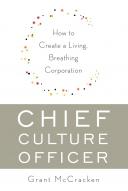
Ok, so we already knew about CEOs (Chief Excutive Officers), CIOs (Chief Information Officers), CFOs (Chief Financial Officers) and who knows how many other kinds of Chiefs are vital for the survival of a company. Apparently, we are not out of the wood yet. According to Grant McCracken, companies need CCOs (Chief Culture Officers) to complete the list. It’s not a new notion, but he wants to put it back in fashion.
But who is Grant McCracken to tell us that we need a new « Chief » category anyway? And what does a CCO eat?
Meet the author

Grant McCracken – Culture and Consumption from Fade To Play
Grant McCracken is the creator of a blog that « sits at the intersection of Anthropology and Economics ». In top of being an anthropology Ph.D. holder, he is also a student of American culture. He has published several books including Chief Culture Officer: How to Create a Living, Breathing Corporation, our new discovery. As a consultant, he has worked for giants such as Coca-Cola, Ikea and Chrysler. He is an expert in the field! But what field exactly?
Don’t you confuse culture with culture
Right Now McCracken’s field is culture. McCracken believes that culture is the corporations’ last mile, something that is being neglected and ignored. What exactly is « culture »?
In interview McCracken admits that culture isn’t really tangible. He describes it as:
A software, ideas contained in our heads, emotions contained in our hearts, habits and practices that we play out in our lives everyday. (…) It’s the set of meanings that help us understand what is happening around us.

It is vital that all employees around the globe understand the corporate culture of the company they work for.
Ok. This is where we need to pause for a second and look up other sources. What McCracken defined above is culture, but we also need to understand the concept of corporate culture.
In its book Powerful Corporate Communications, Paul Argenti describes Corporate culture as the « internal version of a brand ». Corporate culture encompasses the mission, the vision and the values of a company. A corporation that fails to promote its own culture internally will have a hard time promoting and defining its brand externally. A company that is not self-conscious of its internal culture, will struggle to adapt to external factors such as the culture of a country.
A good example of corporate culture clashing with national culture is Toyota’s recent PR disaster. The Japanese company practices secrecy of information because it is part of its corporate culture. Here’s the hitch. In the U.S., transparency (or at least a semblance of transparency) is the norm. The secrecy of Toyota’s corporate culture collided with America’s transparency culture and the rest is history. Ideally, a CCO would have been able to make sure that Toyota’s culture didn’t conflict with the American culture.
Non-success stories

Skinny vs. Baggy. Levi wasn't quick to recognize the hip-hop trend.
Back to the book, Chief Corporate Culture. The book explains how powerful corporations have lost big business opportunities because they fail to recognize the importance of national culture. For example, Levi Strauss let slip a market opportunity because they underestimated the potential of the hip-hop trend. The jeans and apparel maker didn’t realize that « kids in baggy jeans represented a whole new—and lucrative—market opportunity ». Their inability to identify what shaped the American culture resulted in the loss of billions dollars.
It may be tempting to blame Levi Strauss but you would be wrong to consider that the CCO position is just about looking hip in a fresh pair of denim. Being a CCO is not as cool as it sounds because it involves responding to coming changes, « even when they only exist as the weakest of signals. »
What CCO eat: Google it
Once more, our favourite search engine proves to be one of the most innovative companies. Four years ago, Google hired its first CCO, Stacy Salvides Sulivan. The mission of Stacy is to « retain the company’s unique culture » and keep the over 20,000 full-time employees happy. Being a CCO involves talent management, employee relations and internal communications. Sounds smells like HR with a good dose of PR. In interview, Stacy Cnet shares more details on the challenges met in the course of her duties.
Reviews

Chief Culture Officer: How to Create a Living, Breathing Corporation
Chief Culture Officer: How to Create a Living, Breathing Corporation was released last December. It’s about time we grab a copy of it! So far, the book has received positive reviews:
In Chief Culture Officer—a delectable cultural soup that is sure to stir your taste buds—Grant McCracken makes a compelling case that culture will be marketing’s next silver bullet. I whole-heartedly endorse his call for bringing culture-thinking into the company.
Philip Kotler, author of Chaotics: The Business of Managing and Marketing in the Age of Turbulence

